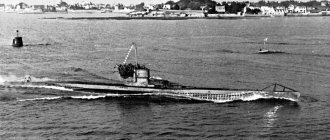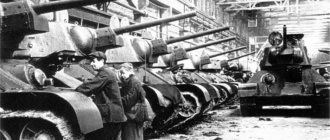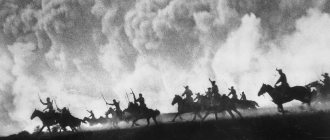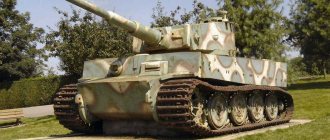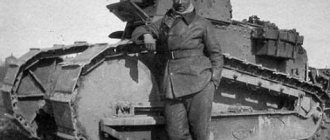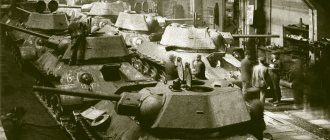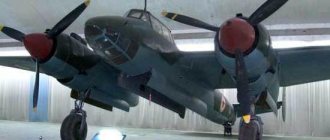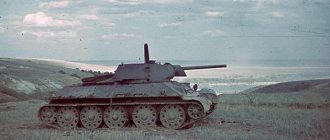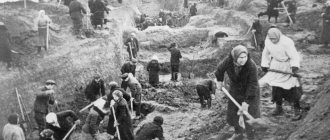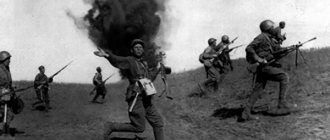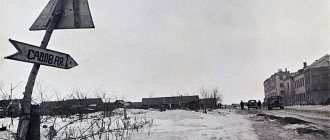Soviet
In total, there are about 60 different armored vehicles, including those received under Lend-Lease and with the exception of experimental ones or those not in mass production.
The most outstanding are the following Soviet tanks of the Great Patriotic War.
T-50
A light tank released to replace the outdated T-26. During development, the designers were inspired by the German PzKpfw III, which has excellent mobility and reliability for its class.
A total of 77 units were produced, and the car itself was considered successful. The appearance of the T-34 made the T-50 practically unnecessary, which is where the history of this combat vehicle ended.
T-28
This medium three-turreted tank is often not given due attention, however, it was superior in performance characteristics to most Wehrmacht tanks in the initial period of the war.
Good armor and firepower were often not used due to inexperienced crews and worn-out equipment. Reliability and service life were extremely low, and the multi-tower design had already become obsolete.
The Red Army used the T-28 until 1944, and Finland until 1951.
T-34
Medium T-34, known throughout the world and which has become one of the symbols of victory. The most massive, superior in characteristics to the enemy at the time of its appearance. Simple and cheap.
Later, the Germans acquired the Pz.Kpfw.VI Tiger, Pz.Kpfw. Tiger Ausf. B and PzKpfw V Panther, which had better armor protection and firepower, but their reliability, mass production and cost left much to be desired.
The T-34 and its modifications T-34-57, T-34-85 remained the most popular until the end of the war, despite the emergence of more advanced equipment.
KV-1
The heavy KV-1 seemed like a real monster to the German army at the beginning of hostilities.
Reliable armor, granting the vehicle virtually invulnerability, but extremely low reliability and poor maneuverability made the KV-1 extremely controversial.
The appearance of the Pz.Kpfw.VI Tiger, which had no difficulty in penetrating the armor of Soviet vehicles, immediately put an end to the KV-1, which had lost its only advantage.
IS-2
The heavy Soviet IS-2, the successor to the IS-1, was created as a counterweight to the German Pz.Kpfw.VI Tiger.
Opinions often differ on the assessment of this machine, but no one questions its effectiveness. The 122 mm cannon and sloped armor made the IS-2 an excellent assault tank, capable of performing any tasks on the battlefield.
In terms of individual characteristics, “Joseph Stalin” was inferior to its German competitors, but in total it was superior.
A tangible advantage was its reliability, which allowed it to travel about 1000 kilometers without breakdowns.
IS-3
This heavy tank was late to the war and was only able to take part in the Victory Parade in Berlin, where it made a huge impression on Western observers.
The IS-3 has the most powerful armor, made in the form of a “pike nose”, a 122 mm gun capable of breaking through the armor of a Pz.Kpfw.VI Tiger from a kilometer, but it has shortcomings that extend back to the IS-1.
SU-152
The heavy self-propelled gun is nevertheless essential on this list. It first appeared on the Kursk Bulge, where it was used as a tank destroyer.
She received the nickname “St. John’s Wort” because she was credited with the mass extermination of German equipment with animal names.
In fact, Soviet soldiers often mistook shielded medium PzKpfw IVs for heavy Tigers, and Ferdinand was the name given to any enemy self-propelled gun.
In any case, the SU-152 "St. John's Wort" played an important role in ridding the Red Army of tiger fear.
M4 Sherman
Finally, let's remember the American average Sherman. Second in number after the T-34, it was actively supplied to the USSR under the Lend-Lease program.
Very tall, quite vulnerable and a fire hazard. On the other hand, there are good surveillance devices, maximum manufacturability and room for modernization.
The Sherman did not become a revolutionary vehicle, but it was produced in huge quantities and modified based on experience in use.
Heavy tanks of Germany
German TTs start with two Tier 6 tanks, then one of the branches diverges into two, resulting in three branches with Tier 10 tops. In the next screen, tanks that should be pumped up and left in the hangar are highlighted in green, controversial vehicles that do not always feel good in random mode (pumped up and left at will) are highlighted in yellow, and tanks that are worth pumping up and left in the hangar are red - due to significant shortcomings, they should not be left in the hangar.
Recommended order of leveling (features of branches):
- Tiger II/E 75 (the most balanced tanks)
- VK 01 P/Maus (for lovers of brutal cars)
- VK02 B/Pz. VII (powerful armor with reservations)
Now in more detail about all the branches.
3.1. Line E 100
We will start with the most current branch today with the most balanced vehicles that perform well in random battles. These tanks are distinguished by good guns, fairly good armor and acceptable mobility. In general, they have everything for effective play on all maps, but with some features.
VK 36.01 H (6th level)
A small, tightly knit weight that from the very beginning gives an idea of the game on German TT. A large number of hit points (HP) and thick armor make him a difficult target for his classmates. Especially when tanking in a diamond shape, since the armor plates are at an irrational, almost right angle. The sides are also quite strong. But the tank pays for this by being slow both in terms of gaining speed and turning the hull and turret. But it is not as blind as the “tips”; the basic visibility is 370 m. The gun is generally pleasant - with good accuracy for its level and a downward declination of -8 degrees. But the damage per shot (220 units) and penetration (145 mm) are not enough. For comparison, the Soviet six T-150s have damage of 300 units. and penetration of 167 mm with close damage per minute (DPM) of about 1900, no worse than armor and mobility. This is not to mention the seven (IS) with damage of 390 units, with which this tank gets into battles. So the exchange of 220 for 390 HP, also with less penetration, will not be in favor of the German, which makes him sad in battles. So, decide for yourself whether to leave the car in the hangar, it all depends on how much you like heavy weights and whether you will play at the sixth level. Personally, I kept it in the hangar for a long time, but then I finally sold it, because there are many other faster and more damaging vehicles (the same T-150), which are more interesting and effective to play.
Tiger I ( level )
One of the most famous “historical” tanks that took an active part in the battles on the fields of World War II, which is what captivates many people in this game. Indeed, the car is attractive and enjoyable to play in its own way. The tiger has a good weapon for its level with good alpha (280 mm), penetration (203 mm) and a well-developed DPM (about 2250 units without equipment and other things). In addition, the tank is quite nimble, despite the fact that it is heavy, and the visibility is 380 m. The catch is that all this is to the detriment of the armor - it seems to be there, but because of the right angles it is difficult to implement it, the tiger breaks through relatively easily by your classmates. Although posing in a diamond shape saves you from penetration every once in a while, a large margin of safety (1500 HP) and rate of fire allow you to effectively exchange and shoot most opponents. In general, the tank is well balanced and pleasant to play on; if the armor doesn’t bother you, you can leave it in the hangar. Personally, I did not do this, since the next vehicle is much better for battles, which both tanks often find themselves in.
Tiger II (level 8)
Also a beautiful historical tank, although it has not become as widespread as its predecessor and does not often participate in real battles, also called the royal tiger (KT). It is seriously different from the seven because it has stronger armor with serious angles of inclination, which makes the top sheet (VLD) practically impenetrable. The turret's forehead is also quite strong, the hatch is small and difficult to get into. But when turning, the tower begins to break through, since on the sides there are large sheets with irrational angles (unlike the cast Soviet towers starting with the IS-3). But this is actually not a big problem, the most vulnerable point is the large bottom sheet (NLD), which is pierced by classmates if the CT is standing straight with its forehead. It’s quite difficult to hide it behind cover; all that’s left is to “diamond” it. Fortunately, the sides are strong enough and allow you to unscrew the NLD at such an angle that it becomes much more difficult to break through it. As for the gun, it has excellent accuracy and good air pressure (-8 degrees). Penetration of 225 mm is typical and quite sufficient for a level eight TT, and the alpha was even increased from 320 to 360 units, now it’s even better to play on the “royal”. The only thing I would like is a little more mobility, but now this is easily solved with a turbocharger. There are no complaints about the review - 390 m is a decent indicator. In general, this is now one of the best tier 8 TTs, you can play it effectively - block and shoot damage, hitting hatches even from a long distance. The tank is worth leaving in the hangar; it is better than its classmates in many aspects.
E 75 (level 9)
One of the strongest, and according to many, the best level nine TT in the game. Outwardly, it is practically a copy of the royal tiger and inherited all the best from it, receiving even tougher almost ultimate armor and a weapon with a decent alpha (530 units). This fiend is a real headache for those who face it head-on. After all, breaking through it even in NLD at an angle is quite difficult even for dozens. At the same time, it is also more mobile compared to its predecessor, and its visibility is 400 m. In general, it is practically an imbecile that has no weaknesses, I think that it will not be nerfed soon, since not so long ago it was dropped along with the entire branch. It is highly recommended for lovers of real weights and bending!
E 100 (level 10)
A rather controversial vehicle in modern random games, until recently it had a number of serious shortcomings that prevented this tank from being properly implemented in battle. Namely, a weak turret forehead at a bad angle, penetrable even at lower levels, and a gun with low DPM and penetration. This is not to mention the fact that this is a slow, huge barn with a giant, easily penetrated NLD and the same sides of the tower. In general, just a big piece of... free damage to the delight of the opponents. However, his up led to the fact that the tank began to be actively rolled out into the random lane again. He was given a stronger turret forehead and a gun from Mouse (which is installed by default and does not require pumping), but with a higher rate of fire and, accordingly, DPM. This significantly increased the survivability and effectiveness of the vehicle in battle. However, the tank is still demanding on skill, because the large cardboard NLD and the need to correctly turn the turret have not gone away. Sotka cannot simply push the direction with its forehead, it is more of a positional tank - it hid the NLD, you tank with its sides and shoot damage, turning away the turret after the shot. Alone against a group of enemies, he is also vulnerable, since at the tenth level they will simply throw “kumys” at the tower’s forehead. But now only guns with high penetration (330-340 or more) will penetrate well; some Levandovsky and many other tanks with a penetration of about 315 mm can already be tanked. As for the top weapon, it has not changed - it remains the same as an oblique gold-dependent “drill”. You can only shoot from it at point-blank range and then with questionable effectiveness, since the cost of an error is high - reloading is long (DPM is low). It is practically impossible to target someone even at a medium distance, since aiming takes forever, and the projectile flies in an arc and everywhere. And in battle such a need often arises, so the top barrel is now poorly playable. Otherwise, the tank is like a tank - the mobility is not bad compared to the Mouse (the speed is mostly enough), the visibility is 400 mm. The sides are well protected by screens from KS shells, but they are large and penetrate at right angles; it is not worth exposing them. In general, the tank is brutal, with its own strengths and weaknesses; playing it is not as easy as it seems. He is more vulnerable at his level than the nine, which is where many should stay in this thread. If we talk about playing in tens, then the Soviet IS-4, in my opinion, is much better protected and more versatile in terms of use.
3.2. Maus branch
This entire branch is more questionable about the need for leveling, since all of its tanks are quite controversial in terms of use in a modern random game. No, they are not completely bad as you might think from the highlights on the diagram, but they have significant drawbacks that do not always allow them to be implemented effectively, first of all, they are slow and large in size.
VK 30.01 P (6th level)
Once upon a time it was a ST and quite interesting, since along with a good gun and armor (as for a medium tank of the sixth level), it also had excellent mobility. It was easy and fun to play; I didn’t even want to part with it for a long time and kept it in the hangar. But then it was transferred to the TT, taking away its mobility, and in terms of armor it is noticeably worse than the VK 36.01 H on the parallel branch. In general, the result was a heavyweight with a large square hull without armor. So I don't want to play it now. As a pass-through vehicle, the tank is acceptable, but since there is definitely no point in leaving it in the hangar, I decided to highlight it in red. In a modern random game it is not needed, so we will not consider the characteristics.
Tiger P (level 7)
Prosh is very similar to his twin brother Tiger I, but with significant differences in characteristics that affect the gameplay. The main difference concerns the armor; for its level (and even higher levels) it is quite decent (200 versus 100 mm in the front of the hull). But who will shoot at the hull when there is a flat forehead of the turret with only 100 mm of armor!? In addition, the tank is simply terribly slow, and the DPM leaves much to be desired (1750 versus 2250 for the first tiger). In general, the extras disliked it fiercely, but newcomers will go through it more or less tolerantly, since there are “noobs” and simply self-confident eight players who don’t bother shooting at the “diamond-shaped” Porsche in the forehead of the hull and are surprised at the failure to penetrate. In general, he knows how to forgive mistakes, the visibility of 380 m allows you not to remain a completely blind kitten, but you definitely don’t want to leave him in the hangar.
VK 100.01 P (8th level)
A kind of “mini-mouse”, which many people dislike for its slowness and “barn” behavior, but in vain. It should not be underestimated, since it has a rather formidable weapon with a huge alpha for its level (440 units), serious armor and the amount of HP. Shooting 2-3 thousand damage on it and tanking 3-4 thousand is as easy as shelling pears. In my opinion, this already speaks for itself. The disadvantages include a low top speed (20/15 km/h), but it picks up and maintains it perfectly, and with a turbocharger this turns into a more acceptable 25/20 km/h. Please note that he goes backwards almost as fast as forwards and this feels really cool in battle. Unfortunately, he also does not willingly turn his hull and turret, but here the UMP and the Virtuoso crew perk already come to the rescue. In general, it is possible to achieve a minimum acceptable level of mobility, although on large maps the tank is still a little behind (30 km/h would be just right). The main weak points are a small NLD (can be treated with a diamond) and a large, strong commander's hatch on the turret (it can be broken through once). But it has very strong sides (they are solved in a diamond shape) and it can quickly roll back (it is more difficult to aim the hatch). In general, the tank is very strong and underrated, I personally, as a lover of brutal cars, really like it, and the visibility is 400 m. It’s worth leaving it in the hangar or at least trying it out, you can perform LBZ on it, you’ll feel approximately how it will be played on the Mouse, you’ll be able to understand Is it worth going further?
Mauschen (level 9)
Apparently, when reworking the branches of German heavy tanks, the developers simply had nothing to fill the ninth level with and they decided to stick this “mouse” on it. To be honest, it turned out so-so... almost Mouse - with the same speed and mobility, but weak armor. The tank gets into battles with dozens, where it is simply fodder. What can I say, even nines on main shells and eights on gold easily sew it into the forehead of the turret and straight sides, plus a huge hatch, lack of protection under the turret, a machine gun... significantly less HP (2300 versus 3000 for Mouse) and low DPM (2050 versus 2300). In general, the tank feels very sad at its level and there is no point in leaving it in the hangar. If you want real brutality, go further to ten.
Maus (level 10)
A very serious opponent for classmates with insufficient penetration on gold (KS less than 330 mm and rebound BP without normalization). Many simply cannot do anything to him or turn around and leave “without a sip.” Thanks to phenomenal armor and a huge safety margin, the tank has enormous survivability, and an accurate weapon allows you to confidently inflict damage. However, on some maps, Mouse simply does not have time to get anywhere, either ending the battle without damage, or becoming the last victim of a flock of opponents. This is the price of sometimes feeling like the owner of a random house. If you think it's worth it, that's your choice. At level ten there are more universal vehicles that can find a place on any map, so the Mouse is no longer very relevant.
3.3. Pz.Kpfw branch. VII
This branch starts with the Porsche Tiger, which will give you quite a bit of trouble, especially if you open two eights on it, leading to different branches. The eight here is just a passable one, and the main machines are at levels 9 and 10.
VK 45.02 A (8th level)
Despite the fact that this tank is passable, it is quite pleasant in the game - nimble, quick-firing, with a good air-damage rating. But, as usual, it is not without its drawbacks - weak armor and low penetration by main shells are the scourge of this vehicle, because of which you don’t want to leave it in the hangar.
VK 45.02 B (level 9)
Objectively, the strongest tank in the branch - it has very powerful armor (even an NLD without a diamond is very difficult to penetrate) and a level ten gun with a good alpha (490 units). The “sneaker” pays for this with disgusting mobility and a rear-mounted turret with a poor air-injection level (only -5 degrees). The main feature is tanking in a diamond pattern and from the sides; if implemented correctly, you can push through directions without taking almost any damage. In terms of armor, the tank is stronger not only than its “colleagues” in neighboring branches (E 75 and Mauschen), but also among the top ten in its own branch (E 100, Pz. VII). In general, the tank is strong, but due to its slowness and rear turret position, it is not very popular. It is recommended to download only for ardent fans of brutal cars and stop there.
Pz.Kpfw. VII (level 10)
It is a continuation of the concept of heavily armored strands with a rear turret. The tank is basically strong and sometimes you can bend over it (for example, in a battle of bloggers). Its weapon is better both in terms of alpha and DPM, and also UVN -7 degrees. The car is definitely more comfortable and a little faster than its predecessor. However, due to vulnerable areas, seasoned tankers are able to quickly send you to the hangar. The problem is the weak pursuit under the turret, which becomes available with small additional turns of the hull, and the “cheeks” of the turret itself are penetrated with gold with a bang. So playing on this machine requires caution, you only need to tank with your forehead (trying to hide the NLD) and maneuver at least a little so that you don’t get hit in the tower. If these rules are observed, the tank is capable of a lot, but it does not reach the invulnerability of the nine. However, it is easier to play on it than on Sotka and Mouse; it is suitable for those who like to push with armor.
German
Inspired by the success of Blitzkrieg, German tankers tried to continue its strategy in the Great Patriotic War, but were faced with serious equipment, a huge army and stubborn resistance. The culmination was the battle of Prokhorovka, called the turning point of the war.
However, we must pay tribute to the designers from Germany and list some German tanks of the Great Patriotic War.
Pz.Kpfw III
The medium Pz.Kpfw III combines good mobility, reliability, crew comfort and modernization potential.
The Pz.Kpfw III was produced until 1943, as modernization reached its limit and the vehicle could not compete with heavier models like the T-34, equipped with better sloped armor and powerful weapons.
Pz.Kpfw IV
The medium Pz.Kpfw IV has become a real workhorse. It was created as an assault tank capable of suppressing enemy firing points.
During the war, the Pz.Kpfw IV was constantly modernized, receiving screen armor and a long-barreled 75 mm cannon. Due to the increase in mass, the latest modifications had mediocre cross-country ability.
After the end of the war, it was in service with some countries for a long time.
PzKpfw V "Panther"
A medium tank, considered heavy by the USSR and its allies.
The Panther became an extremely controversial car, as it had both bright advantages and serious disadvantages.
Good frontal armor, located at an angle, a powerful and incredibly accurate gun, good vertical aiming angles, comfortable working conditions for the crew.
At the same time, the thin side armor precluded the vehicle from being used in an offensive, the 75 mm cannon caliber made firing high explosives ineffective, and the high cost and complexity of the design made production difficult.
PzKpfw VI Ausf. H1 "Tiger"
Heavy PzKpfw VI Ausf. H1 "Tiger" inspired fear with its very appearance. During its creation, they gave priority to protection and firepower, sacrificing maneuverability, cost and reliability.
With its appearance, it made Soviet KVs unnecessary and could easily hit any equipment from afar with its 88 mm cannon, until the IS-2 appeared. However, even against this formidable new product, the Tiger did not look like a whipping boy and could compete.
PzKpfw VI Ausf. B "Tiger II"
The last serial heavy tank of the Wehrmacht, characterized by very powerful frontal armor at the expense of mobility and reliability.
In a theoretical head-on duel, Tiger 2 was superior to any opponent due to its armor and 88 mm cannon, but in practice such clashes were rare.
The vehicle, weighing almost 70 tons, was unable to operate effectively in front-line conditions, and its reliability was very mediocre.
Panzerkampfwagen VIII "Maus"
The super-heavy experimental Panzerkampfwagen VIII “Maus” did not have time to fight, but managed to impress Soviet and Western designers. 189 tons of mass, 128 mm gun, electric transmission - all this is the Mouse, developed under the leadership of Ferdinand Porsche.
2 prototypes were created, blown up by the Germans so that the developments would not fall to the enemy. At the moment, one Maus is in Kubinka, where it is still amazing in size.
Jagdpanther
Self-propelled guns, tank destroyer, created on the basis of the Panther. Good dynamics and maneuverability, a powerful 88 mm gun, but poor reliability and poorly protected sides.
Ferdinand
A heavy self-propelled gun that performs the role of a tank destroyer. It caused fear among Soviet soldiers and had virtually invulnerable frontal armor.
Ferdinand was created on the basis of the experimental Tiger (P), which is why it received ambiguous characteristics. Incredibly thick frontal armor up to 200 mm thick, a powerful and accurate 88 mm gun made the self-propelled gun a very dangerous enemy. But in practice, the Ferdinands suffered from low mobility and reliability; the vulnerable chassis made it possible to immobilize these vehicles, and the invulnerable frontal armor did not protect against mine explosions.
Tanks of the Third Reich. Secret Blueprints of Nazi Scientists
In 1933, shortly after coming to power, Hitler rushed to the Berlin suburban district of Kummersdorf, where a tank training ground was located. The newly appointed Reich Chancellor demanded to demonstrate to him the equipment of mechanized troops. And although the equipment was weak - just motorcycles with sidecars, outdated armored vehicles and light T-I tanks - the clang of metal delighted the Fuhrer.
Having completed the inspection, in the book for honorary visitors to the test site, he wrote in a sweeping manner:
“Germany will have the best tanks in the world!”
The army flatterers, eager to curry favor, coined the word “Panzervater”, which meant “father of tanks”. This is how designer Ferdinand Porsche was called in the corridors of the Reich Chancellery, who, together with his son Ferry, managed the affairs of the design company.
German tanks leave the tank factory
Having created the very successful Volkswagen passenger car, both Porsches now sought to perpetuate their names by fashioning armored monsters from Krupp steel for the Wehrmacht. The security service took care of maintaining the company's secrets, secret drawings were kept in safes with clever locks and automatic alarms, armed SS men stood at the doors of the laboratories...
Tactical and technical data of German tanks during the Second World War can now be found in reference books. But the behind-the-scenes affairs remain a mystery to many today. Meanwhile, the zigzags of the design thought of German engineers, intertwined with the wild fantasies of the Fuhrer, are very instructive.
Military historians have more than once written about amateurish attempts to quickly issue various types of terrifying superweapons to the Third Reich during the war. As a rule, such monsters turned out to be stillborn, and quite rightly, the attempts of their creators were classified as manifestations of technical adventurism. The specialists of the Krupp concern cannot be called amateurs.
However, the example of tank affairs shows especially clearly how the political adventurism of the Nazi bosses entailed adventurism in design decisions and very soon led Porsche and his colleagues to a panicked revision of all previously accepted design principles, and then to weapons models that never made it to the front .
The main principle of the fascist plans of aggression is well known - blitzkrieg, lightning war. Military equipment was also prepared in accordance with this doctrine. Design developments were aimed at solving problems of the current day or the near future.
For German concerns and monopolies, this was very profitable, because the sales market for a variety of deadly weapons was secured, and with established large-scale production, it was considered quite sufficient to carry out only minor improvements that were not associated with large costs. Industrialists willingly accepted the theoretical formula issued by the strategists of aggression: “The war must be won with the weapons with which it was started.”
Since Hitler's first visit to the Kummersdorf training ground, armored vehicle builders presented the Fuhrer with three models of tanks: the light T-II, the 20-ton medium T-III and T-IV. Their armor did not exceed 30 millimeters, and the main weapon was a rapid-fire cannon with a caliber of 37 millimeters. In anticipation of a lightning war, the main quality of these vehicles was chosen - increased speed. On a good road, the T-III could reach 55 kilometers per hour. German designers did not count on mud and difficult terrain.
The occupation of France and other European states seemed to confirm these calculations. Military campaigns were short-lived, and the tanks were indeed better than those of their opponents.
In the summer of 1940, an order was given to stop all research and design work in the field of weapons that could not be completed within one year. The design of high-power tank guns and a heavy tank model that had begun was suspended. All efforts were devoted to replacing outdated tanks in the troops with new T-III and T-IV.
Before the attack on the Soviet Union, the Nazis concentrated 3,712 vehicles on our border.
The Nazis did not have any clear idea about the T-34 and KV tanks with anti-ballistic armor, diesel engines and a 76-mm cannon, which were adopted by the Red Army in December 1939. The appearance of these machines at the front came as a complete surprise to the Nazis.
“In the Vereya area,” recalled German General G. Blumentritt, “T-34 tanks, as if nothing had happened, passed through the formations of the 7th Infantry Division, reached artillery positions and literally crushed the guns located there.
Popular articles: Russian Ahnenerbe - Research Center "Romb", project "Orion"
It is clear what impact this fact had on the morale of the infantrymen. The so-called “tank fear” began.
T-III and T-IV, with which the General Staff was completely satisfied, could hit our “thirty-fours” from a distance of no more than 500 meters, and even then only at the side or stern. The heavy KV was generally on the verge of being an indestructible tank. The fight against the latest Soviet vehicles had to be entrusted to anti-aircraft artillery and aviation, because the main German anti-tank gun of 37 mm caliber turned out to be unsuitable for this purpose.
Guderian was the first to wake up, having seen with his own eyes how his mechanized divisions were melting away on the battlefields. He raised the question of changing the design of German tanks. The principles “a war must be won with the weapons with which it was started” had to be abandoned. When it became clear that the blitzkrieg plans had failed, the fact of the technical superiority of the Soviet tank units reached the consciousness of Ferdinand Porsche.
A group of specialists went to the front in November 1941 to study the T-34. They heard a proposal from army officers: to build a copy of the “thirty-four” at Krupp factories, using captured samples of these machines. Such advice turned out to be deeply offensive to the “Krupp spirit,” but the main reason lay, of course, not in the wounded design pride. The production of many parts of the T-34, especially its diesel engine, was impossible to establish in a sufficiently short time.
The idea of complete copying had to be abandoned. In addition, although the army wanted to get a maneuverable tank equivalent to the T-34, Hitler demanded that the emphasis be placed on something else: to increase the penetrating power of the projectile by using a long-barreled gun, and at the same time increase the armor: a lighter and faster tank should give way to a heavy one, with a long-barreled gun caliber 88 millimeters.
The design of a heavy vehicle, begun back in 1939 and then suspended, now continued with feverish haste. After the Fuhrer’s demands, she gained weight, turned into a 55-ton block of steel and received the terrifying name “tiger”. This weight precluded its release in large quantities. The Armament Directorate was forced to order another tank, more maneuverable and approaching the T-34 in weight.
But the vehicle, which emerged from the heavy armor, with its 45 tons, caught up with the original estimated weight of the “tiger”. To compensate for the complete powerlessness of the German 37-mm and 50-mm guns against powerful Soviet tanks, they also decided to order the Jagdpanzer self-propelled gun.
The passion for gigantism that suddenly overcame the designers was reflected here too. They gave birth to a hulking monster with full armor and an 88-mm cannon that had a small angle of fire. The soldiers at the front nicknamed him “the elephant.”
The decisions made in the winter of 1941 after the defeat of the Nazis near Moscow meant a hasty revision of the previous approach to tank armament. In accordance with the new doctrine, the production of light T-IIs in 1942 decreased sharply. While waiting for the designers' plans to be translated into metal, they began to launch production of T-III and T-IV with thicker armor.
But the T-III, which until recently was admired for its high, almost car-like speed, was not saved by modernization. Due to weighting undertaken twice, it lost its passability, and a year later its production had to be discontinued.
The army and political elite in Germany were waiting for the invincible tank promised by Porsche. Finally, in August 1942, the best craftsmen assembled the first six “tigers”, and the Fuhrer personally ordered them to be tested in battle near Leningrad. The former Minister of Armaments of the Third Reich, Albert Speer, spoke about what happened next in his memoirs: “Everything was tense in anticipation of the result... But it didn’t come to a general test.
The Russians with complete calm let the tanks pass by the battery and then hit the less protected sides of the first and last “tigers” with precise hits. The remaining four tanks could not move forward, backward, or to the side, and were soon also knocked out. It was a complete failure..."
Popular articles: The ghosts of the Third Reich are real
They began to fine-tune and improve the newly designed machine. The release of serial samples was delayed. They began to think about thickening the armor to 200 millimeters.
To appease Hitler, Ferdinand Porsche accepted the development of a project for the most ridiculous supertank weighing about 180 tons. For reasons of secrecy, the new monster received the playful name “maus” (“little mouse”). Putting forward ridiculous projects is no longer just a hasty and abrupt revision of previous principles. A real panic began behind the drawing boards, a design earthquake broke out...
On November 23, 1942, on the very day when the encirclement ring at Stalingrad was firmly closed, an unusual excitement reigned at the Fuhrer's headquarters. Hitler summoned Speer and demanded that he urgently present an expanded tank production program.
The first task: urgently, by May 12, 1943, to provide 500 “tigers” and “panthers”, 90 “elephants”. It was not possible to complete the “extended program” by the appointed deadline.
It was for this reason that the summer offensive near Kursk had to be postponed until July 5, 1943. On the eve of the Battle of Kursk, Hitler addressed the troops in his usual pompous manner:
“Until now, tanks have helped the Russians achieve this or that success. My soldiers! Finally, you now have better tanks than them."
But our tankers already knew the weak point of the Tigers. The turret of these baggy machines with predatorily elongated gun trunks turned slowly. As soon as the armored “beast” has time to fire a sighting shot, our “thirty-four” immediately makes a sharp maneuver and, while the German gunner is turning the turret, hits the “tiger”.
Fights with the first battalion of serial “tigers” (44 vehicles) occurred at the end of 1942 near Stalingrad, when Field Marshal Manstein’s troops tried to loosen the encirclement ring around Paulus’s group. The “invincible” tanks were not successful... And half a month later, when our troops broke through the blockade of Leningrad, at the Sinyavinsky Heights, a shot from a Soviet 122-mm cannon smashed the turret of another “tiger” into iron chips.
The fragments hit the second car with such force that its crew immediately opened the hatches and fled in panic. The intact, completely new “tiger” proceeded under its own power to Leningrad, and then it was transported to Moscow.
The Ural designers, of course, did not sit idle. Back in the summer of 1942, they improved the combat qualities of the heavy KV, and on October 23 of the same year, the State Defense Committee adopted a resolution to quickly establish mass production of self-propelled artillery units. By the beginning of the Battle of Kursk, the Soviet army already had a sufficient number of such vehicles. It was the famous “St. John’s wort” SU-152, created on the basis of the KV heavy tank. The ending of the Battle of Kursk is well known.
In February 1944, the Germans lost Nikopol, where there were rich reserves of manganese. Only after the war it became clear that the German command established a double salary for the soldiers dug in on the bridgehead and promised generous rewards and vacations to Germany for the most distinguished. According to Manstein, Hitler tragically stated back in March 1943: “The loss of Nikopol would mean the end of the war.”
If earlier the production of tanks was hampered by various design changes and transitions from one model to another, now the shortage of strategic raw materials has affected it. While the Nazi leaders in underground bunkers were racking their brains in search of some incredible chances, the Urals, together with the entire country, again prepared surprises for the Nazis.
The T-34s, now armed with an 85-mm cannon, and the most powerful tanks of World War II, the IS-2, went to the front. German headquarters responded with another instruction: Wehrmacht tankers were advised to avoid oncoming battles with the IS-2 and engage them only from ambushes and shelters.
Ferdinand Porsche still went to reports to the Fuhrer, and then conveyed his next instructions to his designers. What else could have been done? The solution was still seen in the creation of new machines. They worked on the “mouse,” although this 180-ton colossus could not cross any bridge without collapsing it. And yet, the useless monster began to be prepared for mass production.
Popular articles: SS Death's Head Ring (Totenkopfring der SS)
The craving for gigantism overshadowed everything. We decided to extend the already long “trunk” of the “tiger”. The caliber remained the same, but the length of the cannon barrel increased to 6.2 meters and was almost equal to the length of the tank. It now weighed 68 tons and was called the “royal tiger.”
In August 1944, on the western bank of the Vistula, one of the Porsche designers personally led a newly formed battalion of the latest top-secret vehicles into an attack. And again a failure.
The very first collision with a T-34 hidden in an ambush, commanded by junior lieutenant A. Oskin, cost the designer his life. As it turned out, the armor of the “Royal Tigers,” despite its exorbitant thickness, was of poor quality and shattered under the impact of armor-piercing shells.
By the end of the war, a “land battleship” weighing more than 500 tons was already in development. It was planned to install the Krupp monster gun “Dora” and two 150-mm cannons on it, and use diesel engines from submarines as engines. There was not enough time or money to build a “land battleship” in metal: the plan remained on paper.
Ever since a design earthquake broke out in the strictly guarded apartments of Ferdinand Porsche's company in the winter of 1941, despite all the abundance of developments there, essentially the same motif was repeated: a longer gun, a heavier tank. “Panzerfather” and his assistants implemented this principle with such enviable consistency that, according to a West German historian, “German industry during the war could never even partially satisfy the demand of the troops for tanks of all types.”
Miscalculations by German tank designers are a fact noted by many military historians from different countries. Here, for example, is what the American publicist W. Manchester writes in the book “Krupp Weapons”: “The gap in technology was new to the Germans, and they never wanted to admit this fact.
If they couldn't solve a technical problem, most of them consoled themselves with the thought that it was completely unsolvable. In the first wartime spring in Russia, after watching Krupp’s tanks getting stuck in sticky Ukrainian clay, they simply gave up and gave this time the name “mud period.” But the Soviet wide-tracked T-34s moved perfectly in the same conditions..."
Having mastered the raw materials resources of many European countries, Germany produced 53,800 tanks in 1941–1944, and our industry produced almost twice as many.
During the war, in addition to the modernization of the T-III and T-IV, completely new vehicles T-V ("panther"), T-VI ("tiger"), T-VIB ("royal tiger") were mastered. The Ferdinand self-propelled gun with electric drive was also a separate design development.
The distinctive features, or rather, defects, of these machines were, along with insufficient reliability, gasoline engines, unreasonably large weight, difficulty in transportation and poor maneuverability.
At the same time, the main Soviet T-34 tank, put into service in December 1939, was produced until the end of the war, and no unjustified changes were made to its design that would complicate its mass production. As for modernization, for all types of tanks it was aimed not only at improving tactical and technical characteristics, but also at achieving maximum technological simplicity, replacing scarce non-ferrous metals with ferrous ones, and reducing labor intensity in the manufacture of units and vehicles in general.
This made it possible to organize conveyor production of tanks. The Soviet Union won the “tank competition” with a great advantage.
5 BEST TANKS OF THE THIRD REICH
Channel "News of Science and Technology": https://goo.gl/yW6aSb In this issue you will learn about the best tanks of Germany during World War II...
Hitler's Supertanks (Tiger and Mouse)
History of tanks Confrontation of tanks USSR Germany Second World War
The film tells the story of the creation of the famous heavy tanks of the Second World War of the USSR and Germany. Their confrontation on the battlefields.
INBREAKABLE German tanks of the Second World War. Armored vehicles and tanks of Germany during the Second World War
INBREAKABLE German tanks of the Second World War. Armored vehicles and tanks of Germany during the Second World War The first tank of the Wehrmacht ...
Super-heavy tanks of the Third Reich
Subscribe: https://goo.gl/ULFodW Our public VK: https://vk.com/history_of_everything Advertising and cooperation: https://goo.gl/0OQMcR.
Similar
Results
We did not mention the large number of armored vehicles used during the Great Patriotic War, but we noted the most interesting and outstanding examples.
It is worth highlighting the main features of the most successful tanks of World War II:
- simplicity, manufacturability, low cost of production, thanks to which mass production was achieved;
- good mobility, allowing the machine to be used in any conditions;
- armor of medium thickness at an angle, due to which the mass remained within reasonable limits with a sufficient level of protection;
- a medium-caliber gun capable of hitting targets head-on with sufficient accuracy, while having a high reload speed and a large transportable ammunition load.
The question often arises about whether there is a best tank of the Great Patriotic War. This is difficult to answer without bias, since there have been examples of equipment that could qualify for this title, but suffered due to circumstances such as improper use or production problems.
However, the Soviet T-34 can be called the best in terms of all its characteristics, and this is unlikely to come as a surprise to anyone.
Yes, it suffered due to the low quality of spare parts, the crew’s working conditions could not be called comfortable, the armor did not protect against German guns in the second half of the war, and the gun at times proved powerless against the frontal armor of German heavy armored fighting vehicles.
But the concept of a medium tank, protected by sloped armor, with sufficient mobility and firepower, turned out to be so successful that the Germans made the Panther, trying to embody their vision of the strengths of the T-34.
Later, the mighty Soviet IS-2, IS-3, the German Royal Tiger appeared, the development of the E-series and Maus began, but it was the medium tanks, which became a compromise of all important characteristics, that gained popularity in the Great Patriotic War and after it, eventually evolving in OBT.
